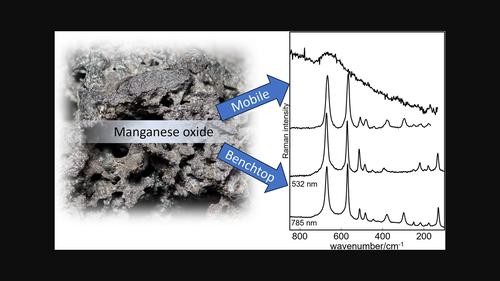当前位置:
X-MOL 学术
›
J. Raman Spectrosc.
›
论文详情
Our official English website, www.x-mol.net, welcomes your feedback! (Note: you will need to create a separate account there.)
Layered manganese oxides structures: Micro-Raman and selected mobile Raman spectroscopic studies
Journal of Raman Spectroscopy ( IF 2.5 ) Pub Date : 2023-12-25 , DOI: 10.1002/jrs.6646 Eva Vermeersch 1 , Filip Košek 2 , Johan De Grave 3 , Jan Jehlička 2 , Anastasia Rousaki 1
Journal of Raman Spectroscopy ( IF 2.5 ) Pub Date : 2023-12-25 , DOI: 10.1002/jrs.6646 Eva Vermeersch 1 , Filip Košek 2 , Johan De Grave 3 , Jan Jehlička 2 , Anastasia Rousaki 1
Affiliation

|
The main structural building blocks that form manganese oxides are MnO6 octahedra; these share corners and edges to construct specific structures, which can either be tunneled or layered. In the layered structures, that is, phyllomanganates, the MnO6 octahedra form sheets, which, in turn, alternate with sheets of metal oxides and H2O. These metal ions can vary (Zn, Co, Ni, Al, Li, …) and give rise to an entire range of different metal oxides. The characterization of these layered materials is important as they have various economical/industrial applications. Birnessite-type materials, a specific type of layered manganese oxides, are widely studied for their use as cathode materials in alkali-ion batteries. Phyllomanganates are also commonly found as constituents in sediments and soils or as coatings on rock surfaces. Their natural occurrence as black colored components have ensured that these minerals were also applied as pigments in archaeological and historical contexts. They are, for example, often found in rock art paintings and on pottery. As the oxides are used in unique archaeological objects, Raman spectroscopy is an evident choice for characterization due to its non-destructive nature of analysis. In the current study, five mineral samples of (layered) manganese oxides are analyzed with different Raman instrumentations, including mobile systems and a benchtop micro-Raman setup. The characterization of each selected manganese oxide and their comparison with literature data is discussed for the micro-Raman instrumentation. In addition, the ability of identifying and characterizing layered manganese oxides and the possible challenges when using mobile instrumentation are discussed as well.
中文翻译:

层状锰氧化物结构:显微拉曼和选定的移动拉曼光谱研究
形成锰氧化物的主要结构构件是MnO 6八面体;它们共享角落和边缘来构建特定的结构,这些结构可以是隧道式的,也可以是分层的。在层状结构(即页锰酸盐)中,MnO 6八面体形成片状,而片状又与金属氧化物和 H 2 O 片状交替。这些金属离子可以变化(Zn、Co、Ni、Al、Li... )并产生一系列不同的金属氧化物。这些层状材料的表征很重要,因为它们具有各种经济/工业应用。水钠锰矿型材料是一种特殊类型的层状锰氧化物,因其用作碱离子电池的阴极材料而被广泛研究。叶锰酸盐也常见于沉积物和土壤中的成分或岩石表面的涂层。它们天然存在的黑色成分确保了这些矿物也可在考古和历史背景下用作颜料。例如,它们经常出现在岩画和陶器上。由于氧化物用于独特的考古物体,拉曼光谱由于其非破坏性分析性质而成为表征的明显选择。在当前的研究中,使用不同的拉曼仪器(包括移动系统和台式显微拉曼装置)对五种(层状)锰氧化物矿物样品进行了分析。针对显微拉曼仪器讨论了每种选定的氧化锰的表征及其与文献数据的比较。此外,还讨论了识别和表征层状锰氧化物的能力以及使用移动仪器时可能面临的挑战。
更新日期:2023-12-25
中文翻译:

层状锰氧化物结构:显微拉曼和选定的移动拉曼光谱研究
形成锰氧化物的主要结构构件是MnO 6八面体;它们共享角落和边缘来构建特定的结构,这些结构可以是隧道式的,也可以是分层的。在层状结构(即页锰酸盐)中,MnO 6八面体形成片状,而片状又与金属氧化物和 H 2 O 片状交替。这些金属离子可以变化(Zn、Co、Ni、Al、Li... )并产生一系列不同的金属氧化物。这些层状材料的表征很重要,因为它们具有各种经济/工业应用。水钠锰矿型材料是一种特殊类型的层状锰氧化物,因其用作碱离子电池的阴极材料而被广泛研究。叶锰酸盐也常见于沉积物和土壤中的成分或岩石表面的涂层。它们天然存在的黑色成分确保了这些矿物也可在考古和历史背景下用作颜料。例如,它们经常出现在岩画和陶器上。由于氧化物用于独特的考古物体,拉曼光谱由于其非破坏性分析性质而成为表征的明显选择。在当前的研究中,使用不同的拉曼仪器(包括移动系统和台式显微拉曼装置)对五种(层状)锰氧化物矿物样品进行了分析。针对显微拉曼仪器讨论了每种选定的氧化锰的表征及其与文献数据的比较。此外,还讨论了识别和表征层状锰氧化物的能力以及使用移动仪器时可能面临的挑战。



























 京公网安备 11010802027423号
京公网安备 11010802027423号